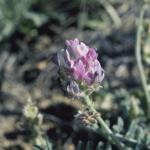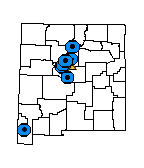Description
Perennial; stems short, prostrate, 1-6 cm long; herbage densely villous or villosulous with basifixed hairs; leaves 4-9 cm long; leaflets (7)9-15, often folded, 3-12 mm long, 2-3 times longer than wide; stipules free; inflorescences taller than or included in the foliage, with 7-12, densely or loosely disposed ascending-spreading pea-like flowers; calyx tubes tubular, 4.5-6.5 mm long, calyx lobes 1-2 mm; corolla 12-16 mm long, pale pink-purple; fruits divaricate-humistrate, sessile, bilocular or nearly so, deciduous, dehiscent, body curved to 180, triquetrous (3-sided), short-beaked, (1)2-3 cm long, 4-5 mm wide, dorsally sulcate (furrowed on side away from stem), valves leathery, reticulate, strigulose. Flowers April through June.
Similar Species
The key features of A. feensis are basifixed pubescence, free stipules, and curved, triquetrous, bilocular pods. When in flower, it looks similar to A. tephrodes var. tephrodes, which also has curved, triquetrous fruits and basifixed pubescence; however the fruits of A. tephrodes are unilocular and it grows in southwestern New Mexico. Astragalus feensis is related to A. waterfallii, another rare plant (southeastern New Mexico and adjacent Trans-Pecos Texas); however, the flowers of A. waterfallii are larger and its fruits are mostly straight. Astragalus feensis is frequently found growing with A. missouriensis, which has dolabriform pubescence.
Distribution
New Mexico, Bernalillo, Sandoval, Santa Fe, Torrance, and Hidalgo counties.
Habitat
Sandy benches and gravelly hillsides in piñon-juniper woodland or plains-mesa grassland; 1,550-1,830 m (5,100-6,000 ft).
Conservation Considerations
Some populations have undoubtedly been affected by urban or rural development, but many populations are isolated, safe from most disturbances, and not threatened by the current land uses.
Important Literature
*New Mexico Native Plants Protection Advisory Committee. 1984. A handbook of rare and endemic plants of New Mexico. University of New Mexico Press, Albuquerque.
Barneby, R.C. 1964. Atlas of North American Astragalus. Memoirs of the New York Botanical Garden 13:1-1188.
Isely, D. 1998. Native and naturalized Leguminosae (Fabaceae) of the United States (exclusive of Alaska and Hawaii). Monte L. Bean Life Science Museum, Brigham Young University, Provo, Utah.







